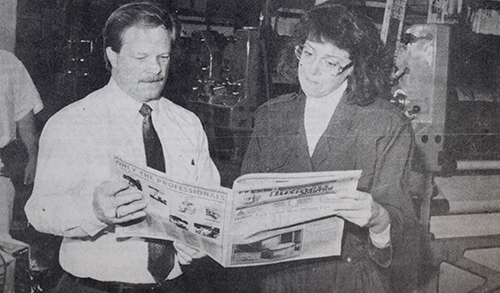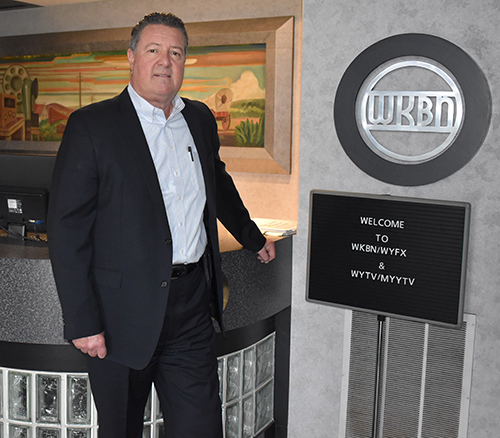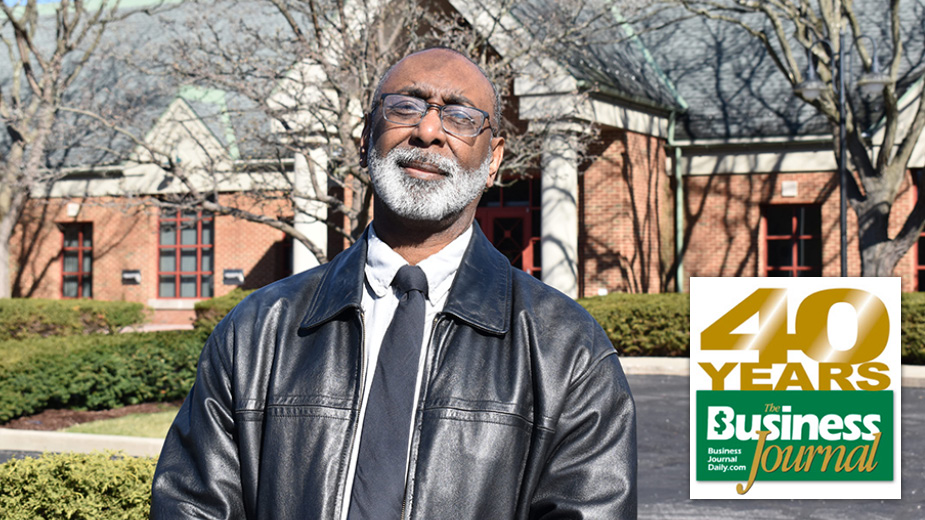YOUNGSTOWN, Ohio – In the four decades since The Business Journal published its first edition, the transformation of the local media landscape – driven by advances in technology and changes in society – has been seismic.
The Business Journal itself has adapted to many of those changes, from the emergence of online publishing to video stories and the growing role of social media.
The most acute change in the Mahoning Valley was the demise of its largest daily newspaper five years ago. While the closing of the original Vindicator was part of a nationwide trend, change has hardly been limited to that singular event.
The way people consume media has been drastically altered in the past 40 years. Content is no longer limited to a print periodical or a television set.
Similarly, how local news content is created has also been transformed and most media outlets are part of ownership groups based in other cities.
NEWSPAPERS
The end of The Vindicator, which published its final edition under the ownership of the Brown family Aug. 31, 2019, was decades in the making, says Ernie Brown, who was a regional editor when it closed. Brown, who is not a member of the family that owned the newspaper, had worked for the paper from 1976 until its closing.

Brown recalls he was encouraged to join the staff of the school newspaper at East High School by an English teacher who felt he wrote well and had good command of the English language.
“That’s where I cut my teeth,” he remembers. “I wrote sports articles. I covered our high school basketball and football teams.” Although he would end up in print journalism, his college degree was in broadcast journalism.
When he started at The Vindicator, the newspaper’s circulation was well over 180,000, reaching from Ashtabula to East Liverpool, Brown recalls. It maintained bureaus in Lisbon, Salem and Warren and in Sharon and New Castle, Pa.
“We had maybe 25, 30 reporters,” he says.
One of the biggest shifts Brown saw during his years as a journalist was the perception of the news media. Brown became a reporter at a time when the profession saw an influx of men and women entering it in the wake of its glamorization following Watergate, he says.
“The press still had a very strong reputation as being objective, sticking to the facts, and being involved in the local scene as far as covering government, politics, and general assignment things – future stories and stuff like that,” he says. “People trusted us.”
Polls show that’s changed. A 2022 Gallup poll found that only 34% of Americans have either a great deal or fair amount of trust and confidence in the media.
Technological changes have ranged from going from Selectric typewriters to computers and from hot type to cold type to the revolution brought about by the internet. In the 1990s, money began to shift from traditional newspapers to websites “because that was the new thing,” Brown says.
Journalists generated content that was posted online, in many cases at no charge to the public, before paywalls were instituted. Content was given away without even a nominal fee being charged because no one saw how they could make money from it.
“It’s kind of like Youngstown thinking that big steel was always going to be around,” he says. Newspapers “were always going to have auto dealers” and Strouss and other big department stores would always be around and advertise in the paper.
Brown says it became clear around 2018 that The Vindicator was in trouble. New reporters weren’t being hired and generating advertising revenue was difficult. “You might go pages before you saw any ads at all. So it became clear that advertising revenue was not there,” he says.
When Vindicator general manager Mark Brown called staffers into a meeting in June 2019, he had assumed it was to announce the paper would go to a reduced publication model as other newspapers had and would move more content onto the website, along with layoffs and cutbacks in the newsroom.
“I had no idea that I would hear these words – The Vindicator was closing – and I was completely amazed,” Brown says. The Vindicator’s name, subscriber list and news website eventually were sold to Ogden Newspapers, owner of the Tribune Chronicle, which now publishes it.
Brown says he is optimistic that there always will be those who “are concerned about ferreting out the truth and holding people in authority accountable.”
The question is how the financial model to sustain that kind of work will be developed. Many journalists are “more interested in drawing attention to themselves via clicks or podcasts” to show what they are doing, he says.
Brown is uncertain whether that is a sustainable model for everyone.
“The thing that troubles me is, who’s fact checking this stuff,” he adds. “Who’s making sure that this information you are taking in is true and is reliable?”
TELEVISION
Unsurprisingly, technological advances have driven many of the changes in broadcast television. But not all of them.
Dave Coy and Jack Grdic, general managers of Youngstown’s television stations, have had front-row seats to see the transformations.
Coy, who manages WKBN, WYFX and WYTV for Nexstar Media Inc., started at the stations in September 1982.
Grdic, who succeeded his father as WFMJ general manager, began at the station full time in 1993. He had worked there for several years before, interning in just about every department.

Into the early 1990s, the Youngstown area had three television stations, two of which were owned by local families, Grdic says. While WFMJ remains owned by the same Brown family that owned The Vindicator, WKBN and WYTV are now owned by out-of-town station groups.
“That’s a significant change,” Grdic says.
WKBN – which in 1997 was sold by the founding Williamson family to Gocom, the first in a series of owners – introduced the first new commercial broadcast television station to the market since the 1950s when it launched Fox affiliate WYFX in 1998.
“We were one of the bigger markets in the nation that did not have a Fox affiliate,” Coy says. Fox carried National Football League programming and had a couple of prime time hits – “Ally McBeal” and “The Simpsons.”
WKBN secured the Fox affiliation by purchasing a couple of low-power television stations and banding them together to simulcast the Fox signal, then distributed it through cable transmission.
Years later, the owner of WKBN and WYTV entered into a joint sales and shared services agreement. Such agreements provide a way for a station “to stay in existence without having a full staff and all of those expenses,” Coy says.
“WYTV was struggling. They were struggling to make money and struggling to survive,” he continues. While many people lament that WYTV is no longer a standalone operation, he isn’t sure the station would be in existence today had it remained one.
The Telecommunications Act of 1996 “essentially deregulated broadcasting,” Grdic says.
Intended to encourage local investment and ownership of TV stations, including minority ownership, the law “exacerbated the polar opposite, where groups took advantage, because now they can own multiple stations in a market,” a situation that affected radio “every bit as hard” as it did television, “if not worse,” Grdic says.
Distribution of signal has evolved in several ways over the years. After decades of “healthy, over-the-air” transmission, cable came to the forefront in the 1980s and 1990s, Coy says.
Once cable established its foothold, satellite companies came in and took 20% to 30% of the distribution. “And now we’re in the streaming world,” Coy observes.
Back in the 1990s, he recalls, people would ask whether cable would put local TV out of business, and now people are asking about the future of cable.
When Grdic started in the industry, WFMJ programming could be accessed only over the air, by cable and by satellite, which was just being introduced. Now, news programming is also streamed live at WFMJ.com and on Apple TV, Roku and Amazon Fire TV Stick, the NBC website and Peacock – NBC’s streaming service, as well as DirecTV, YouTube TV and others.

Coy recognizes the challenge of competing with Big Tech, which includes streaming. Google and Facebook enjoy market capitalization that dwarfs that of even the larger broadcast operators.
Google’s market capitalization is $1.7 trillion and Facebook’s is $1.25 trillion, compared with Nexstar, largest of the TV ownership groups, about 200 affiliates, with $5.5 billion.
“The reality for us is we still have a product,” Coy says, as a provider of local news, sports and weather.
“That’s something that the big boys can’t do. They’re not in [the local news] space. So that’s clearly something that the more things change, the more they stay the same. Local news is still very important for us, especially in an environment where there’s some markets and places where there’s a news desert. We take that as seriously as we ever have,” he says.
Another technological advance Grdic points to is the introduction around 2006 of bonded cellular mobile units, a “game changer” for TV stations because it meant a live signal could be achieved without the use of a satellite or microwave truck.
The technology was more affordable, allowing the station to have live shots from more than one location during the same broadcast.
“Nowadays the technology is used both for multiple live interviews, but also livestreaming of things like speeches, debates, parades and community events,” Grdic continues. “And it no longer matters if these events are in our market or another city or state. We can easily be live from a World Series game in Cleveland or a General Motors meeting in Detroit.”
One of the biggest developments is that websites liberated the TV newsrooms from holding back news to appear first on the next scheduled broadcast.
“We embraced that digital-first mentality,” Coy says. “One thing about digital is that you get immediate feedback on whether or not a story is important to people. We never had that ability on television. So at times it actually helps us craft what’s important on the TV side when we see what’s percolating, what stories are really resonating online.”
The launch of digital television heralded another development for WFMJ, Grdic says. WFMJ initiated its digital signal in June 2003, about six years before stations were required to deactivate their analog transmitters.
The change to digital not only allowed WFMJ to broadcast in high definition but allowed the station to bifurcate its linear signal, he says. This expanded capacity to enable WFMJ to carry something else, leading to the launch of its WB Network affiliate, WBCB, he says.

RADIO
Pittsburgh native Phyllis Gastgeb, market president for iHeartMedia Multiplatform Group – Ohio/Virginia area, started her career in radio more than 20 years ago, and came to the Mahoning Valley in 2021.
The thinning of news operations at local radio stations that once had their own news departments means they rely on content-sharing agreements with other broadcast and print partners. This is happening in larger markets as well, Gastgeb says.
The Youngstown operations of iHeartMedia, which are based in Boardman, encompass six radio stations.
Gastgeb says the merging of media companies is the first major industry change she has seen.
“There’s not as many media companies as there were from a local standpoint,” she says. “Even when you look at iHeartMedia – we previously existed as Clear Channel – so that’s been a big difference. And then, of course, the emergence of digital and social media has really transformed the way that people consume media nowadays.”

The growth of talk radio and its predominance on AM – as experienced locally at WKBN-AM – represents another shift over the decades. One of the media companies for which she once worked, Gastgeb says, CBS-owned KDKA, “the powerhouse AM station in Pittsburgh,” bears resemblance to her current employer, she says.
“I see so much similarity with WKBN,” she says. “That’s what made me fall in love with not just what I do here, but also how well that’s received here in the market.”
In addition to stations broadcasting in mainstream formats, streaming and podcasts offer new ways to reach diverse audiences. IHeart is the top podcaster in the country, with 254 million downloads per month, she reports.
Gastgeb says she is amazed at what her company offers in terms of measuring campaigns and hyper-targeting audiences. “We’re going to continue to grow more digitally,” she predicts.
Pictured at top: Ernie Brown worked for the original Vindicator from 1976 until it closed in 2019.
